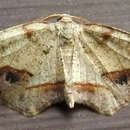Conservation Status
provided by University of Alberta Museums
Not of concern.
- license
- cc-by-nc
- copyright
- University of Alberta Museums
Cyclicity
provided by University of Alberta Museums
Adults fly in Alberta late May to July, peaking in mid June.
- license
- cc-by-nc
- copyright
- University of Alberta Museums
Distribution
provided by University of Alberta Museums
BC east to Quebec (and Nova Scotia?) south to FL and TX (Wagner et al. 2001).
- license
- cc-by-nc
- copyright
- University of Alberta Museums
General Description
provided by University of Alberta Museums
"This smallish geometrid has a pale tan ground colour with heavy brown markings, consisting of antemedian (AM) and postmedian (PM) lines, dark marginal shading, discal spots and (usually) black marginal blotches. Probole are best recognized by the extended outward tooth-like projection of the forewing PM line. More localized and less common than P. alienaria.
Virtually identical to (and previously considered to be conspecific with) P. alienaria. The distinguishing character in wing markings is the angle of the PM line above the "tooth"; it is perpendicular to the wing margin where it meets the edge in alienaria, while in amicaria the line is directed more toward the wing apex, and is essentially perpendicular to the anal (not the costal) margin. Some have treated P. alienaria and amicaria as forms of the same species (eg. McGuffin 1987). Ferguson (in Hodges 1983) treats them as separate species, and according to Handfield (1999), alienaria is a generalist feeder on deciduous shrubs while amicaria feeds only on species of dogwood (Cornus). There also appear to be differences in the male antennal structure among some populations, at least in eastern North America (Handfield 1999). This interesting situation certainly warrants further research in Alberta
"
- license
- cc-by-nc
- copyright
- University of Alberta Museums
Habitat
provided by University of Alberta Museums
Moist deciduous and mixedwood forests.
- license
- cc-by-nc
- copyright
- University of Alberta Museums
Life Cycle
provided by University of Alberta Museums
The caterpillar is a twig or leaf petiole mimic, exhibiting green and brown forms; indistinguishable from P. alienaria larvae. The pupa overwinters (Wagner et al. 2001). Adults come to light, and are also diurnal.
- license
- cc-by-nc
- copyright
- University of Alberta Museums
Trophic Strategy
provided by University of Alberta Museums
According to Handfield (1999), larvae feed only on dogwood, particularly red osier dogwood (Cornus stolonifera). Other reported host records may be referable to P. alienaria.
- license
- cc-by-nc
- copyright
- University of Alberta Museums
Probole amicaria
provided by wikipedia EN
Probole amicaria, known generally as the friendly probole or redcheeked looper, is a species of geometrid moth in the family Geometridae. It is found in North America.[1][2][3]
The MONA or Hodges number for Probole amicaria is 6838.[4]

Friendly probole,
Probole amicaria

Friendly probole,
Probole amicaria
References
- license
- cc-by-sa-3.0
- copyright
- Wikipedia authors and editors
Probole amicaria: Brief Summary
provided by wikipedia EN
Probole amicaria, known generally as the friendly probole or redcheeked looper, is a species of geometrid moth in the family Geometridae. It is found in North America.
The MONA or Hodges number for Probole amicaria is 6838.

Friendly probole, Probole amicaria

Friendly probole, Probole amicaria
- license
- cc-by-sa-3.0
- copyright
- Wikipedia authors and editors


 Friendly probole, Probole amicaria
Friendly probole, Probole amicaria  Friendly probole, Probole amicaria
Friendly probole, Probole amicaria